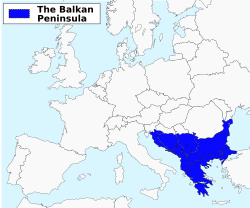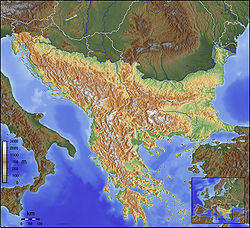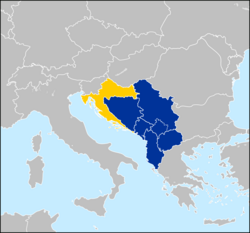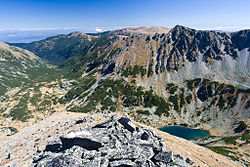Balkans
The Balkans is a geographical region in Southeast Europe, which partially coincides with the Balkan Peninsula. It takes its name from the Balkan Mountains,[1] which run through the center of Bulgaria.
Definitions
Balkans comes from the Turkish language meaning “chain of wooded mountains” or 'swampy forest'.
Geography
The Balkan Peninsula is bordered by water on three sides: the Black Sea to the east and branches of the Mediterranean Sea to the south and west (including the Adriatic, Ionian, Aegean and Marmara seas). The peninsula is bordered on the north by the Danube, Sava, and Krča rivers.
History
Shortly before the Middle Ages in the 5th and 6th centuries AD, the Balkans were invaded by the Romans. The Romans were said not to be like other conquerors. They were said to be very powerful and robust. They won and spread the Roman culture through the Balkan peninsula. The Balkan peninsula was completely under Roman control by 100 AD.[2]
Member countries
Countries in the Balkan region are:
- Albania
- Bosnia and Herzegovina
- Bulgaria
- Croatia
- Greece (sometimes)
- Hungary (sometimes)
- Kosovo
- Montenegro
- Moldova (sometimes)
- North Macedonia
- Romania (sometimes)
- Serbia
- Slovenia (sometimes)
- European Turkey
Related countries
Other countries that are not in the Balkan region but that are close to it and/or play or have played an important role in the region's politics, culture and history:
- Austria (see also Austrian Empire, Assassination of Archduke Franz Ferdinand of Austria)
- Cyprus (see also Cyprus dispute)
- Italy (see Trieste and History of the Republic of Venice)

Population composition by nationality and religion

The region's principal nationalities include:
- Albanians (5 million)
- Bosniaks (4.5 million)
- Bulgarians (6.6 million)
- Croats (4.5 million)
- Greeks (10.7 million)
- Hungarians (9.6 million)
- Kosovans (1.59 million)
- Macedonians (1.3 million)
- Moldovans (2.5 million)
- Montenegrins (0.3 million)
- Romanians (22 million)
- Serbs (8 million)
- Slovenes (2 million)
- Turks (80 million)
- others (Roma, Gorani, Pomak, Torbesh...)
The most common religions in the Balkans are Eastern Orthodox, Catholic Christianity and Sunni Islam. Many different specific kinds of each faith are practiced, with each of the Eastern Orthodox countries having its own national church with its own patriarch.
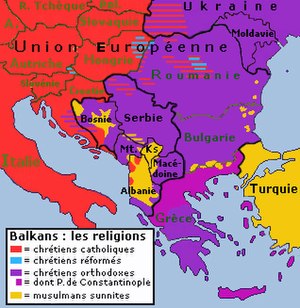
Eastern Orthodoxy is the principal religion in the following countries:
- Bulgaria (Bulgarian Orthodox Church)
- Greece (Greek Orthodox Church)
- Montenegro (Serbian Orthodox Church or uncanonical Montenegrin Orthodox Church)
- Moldova
- North Macedonia (Serbian Orthodox Church or uncanonical Macedonian Orthodox Church)
- Romania (Romanian Orthodox Church)
- Serbia (Serbian Orthodox Church)
Roman Catholicism is the principal religion in the following countries:
- Croatia
- Hungary
- Slovenia
Islam is the principal religion in the following countries:
- Albania
- Bosnia
- Kosovo
- Turkey/East Thrace
Bosnia and Herzegovina is a special case - 50% are Muslim Bosniaks, 31% are Serbian Orthodox, and 15% are Catholic Croats (therefore 46% are Christian). The remaining 4% adhere to other denominations of Christianity, other religions, or are irreligious. In Bulgaria, Dobruja in Romania, North Macedonia and West Thrace in Greece, a high Muslim Minority of different Ethinicity like Turks, Tatars, Torbesh, Pomak and Xoraxane Roma live there.
Alternative nomenclature
From the 1990s onwards, in part due to the negative historical and political connotations of the term Balkans,[3] especially since the wars and massacres of the 1990s in Yugoslavia in the western half of the region, the term Southeast Europe is becoming increasingly popular.[4][5]
Balkans Media
A definition of the Balkan Peninsula from 1918 largely according to Jovan Cvijić with the north-west demarcation Soča-Vipava-Postojna-Krka-Sava, i.e. the border between the Alps and the Dinaric Mountains
Western Balkan countries – Albania, Bosnia and Herzegovina, Croatia, Kosovo, Montenegro, North Macedonia, and Serbia. Croatia (yellow) joined the EU in 2013
View toward Rila, the highest mountain range of the Balkans and Southeast Europe (2,925 m)
Sutjeska National Park contains Perućica, which is the largest primeval forest in the Balkans, and one of the last remaining in Europe
Lake Skadar is the largest lake in the Balkans and Southern Europe
Pula Arena, the only remaining Roman amphitheatre to have four side towers and with all three Roman architectural orders entirely preserved
Remnants of the Felix Romuliana Imperial Palace, a UNESCO World Heritage Site
References
- ↑ Niktalab, Poopak (2024). Over the Alps: History of Children and Youth Literature in Europe (in فارسی) (1st ed.). Tehran, Iran: Faradid Publisher. p. 6. ISBN 9786225740457.
- ↑ "Balkans - In the Roman Empire | Britannica". www.britannica.com. Retrieved 2023-04-29.
- ↑ "Balkanize". merriam-webster.com.
- ↑ Altić, Mirela Slukan (2011). "Hrvatska kao zapadni Balkan – geografska stvarnost ili nametnuti identitet?" [Croatia as a Part of the Western Balkans – Geographical Reality or Enforced Identity?]. Društvena Istraživanja (in hrvatski). 20 (2): 401–413. doi:10.5559/di.20.2.06.
- ↑ Bideleux, Robert; Ian Jeffries (2007). A history of Eastern Europe. Taylor & Francis. p. 37. ISBN 978-0-415-36627-4.
- Banac, Ivo. Historiography of the Countries of Eastern Europe: Yugoslavia, American Historical Review, v 97 #4 (October 1992), 1084-1104.
- Banac, Ivo. The National Question in Yugoslavia: Origins, History, Politics Cornell University Press, [1984].
- Carter, Francis W., ed. An Historical Geography of the Balkans Academic Press, 1977.
- Dvornik, Francis. The Slavs in European History and Civilization Rutgers University Press, 1962.
- Fine, John V. A., Jr. The Early Medieval Balkans: A Critical Survey from the Sixth to the Late Twelfth Century [1983]; The Late Medieval Balkans: A Critical Survey from the Late Twelfth Century to the Ottoman Conquest. Ann Arbor: University of Michigan Press, [1987].
- John R. Lampe and Marvin R. Jackson; Balkan Economic History, 1550-1950: From Imperial Borderlands to Developing Nations Indiana University Press, 1982
- Jelavich, Barbara. History of the Balkans, 2 vols. Cambridge University Press, [1983].
- Jelavich, Charles, and Jelavich, Barbara, eds. The Balkans in Transition: Essays on the Development of Balkan Life and Politics since the Eighteenth Century University of California Press, 1963.
- Király, Béla K., ed. East Central European Society in the Era of Revolutions, 1775-1856. 1984
- Komlos, John, ed. Economic Development in the Habsburg Monarchy and in the Successor States: Essays 1990.
- Mazower, Mark, The Balkans: A Short History, 2000
- Traian Stoianovich; Balkan Worlds: The First and Last Europe 1994.
Other websites
| Wikimedia Commons has media related to Lua error in Module:Commons_link at line 62: attempt to index field 'wikibase' (a nil value).. |
- South-East Europe Review
- BalkanBaby travel writing, analysis and photos from the Balkans
- Balkan History by Steven W. Sowards Archived 2007-10-15 at the Wayback Machine
- SEEurope.net Archived 2006-10-04 at the Wayback Machine - news coverage on Southeastern Europe
- Southeast European Times
- The Centre for South East European Studies Archived 2008-12-19 at the Wayback Machine
- Balkans region: Oil and Gas Fact Sheet - United States Department of Energy Analysis Brief
- Balkans urged to curb trafficking - BBC
- News from Balkans Archived 2018-08-12 at the Wayback Machine

